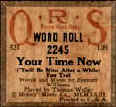Producing accurate sheet music from Fats Waller and Jelly Roll Morton performancesRecently, books have been published containing piano scores for a number of their famous pieces. (Specifically, Thomas "Fats" Waller: The Great Solos 1929-1941, transcribed by Paul Posnak, and Jelly Roll Morton: The Piano Rolls, realized by Artis Wodehouse.) It's interesting to compare how those two recent books were made. In the case of Fats Waller, they were transcribed by hand. Paul Posnak (who is an award-winning classical pianist and professor of music at the University of Miami) describes the process: "The note-for-note transcription of these fifteen Waller solos took me over fifteen years to notate, to learn to play, and to incorporate into my concert repertoire. Note-for-note transcription involves the painstaking process of carefully taping and listening to the LP reissues of the original 78-r.p.m. recordings and reconstructive these improvised performances after multiply replays of each small segment, first on paper, and then at the piano, literally note for note." In the case of Jelly Roll Morton, they were converted mechanically from player piano rolls recorded by the master. During the 1920s, catalogues of piano rolls list 20 recordings by Jelly Roll Morton. Four of these have been lost; sixteen were recovered from collector Michael Montgomery. These sixteen rolls were processed by means of machinery that, like a player piano, uses compressed air passing through holes in the moving paper roll. But the air thus passed, instead of playing the piano, activates switches whose end result is a MIDI file for the song. The resulting sheet must still had to be edited by hand to remove the extra notes that were put into the piano rolls after they were recorded. (I always knew, listening to my cousin Steve's player piano, that nobody could really play all those notes!) Some earlier transcriptions of Jelly Roll Morton's music were made by James Dapogny, who transcribed by hand from Morton's solo phonograph recordings, and set the precedent of rendering Morton's swinging music as eighth notes, instead of 128th and 256th notes. (Dapogny's transcriptions are still available under the title Jelly Roll Morton: The Collected Piano Music.) There wasn't much choice but to follow this precedent in the MIDI files produced from piano rolls, as the rolls themselves were already "quantized" to eighth notes. The metronome markings in this sheet music were produced by measuring the distance between the notes on the piano rolls and applying "a mathematical formula". The player piano was important in the development of a whole generation of pianists. Fats Waller taught himself to play by slowing down a player piano until he could imitate the notes. After that, though, he came under the tutelage of James P. Johnson, one of the pioneers of stride piano. In 1923, when Fats was 19, he also recorded some piano rolls, but apparently these rolls haven't been converted to MIDI and sheet music as of 2006.
John Farrell has gone the opposite direction: he has transcribed recordings, producing MIDI files and piano rolls! See his web page for free midi files and the chance to buy the resulting sheet music.
|
Michael Beeson's Home Page
-->
